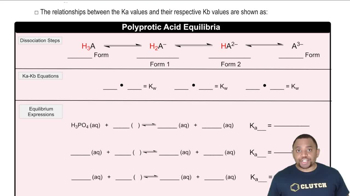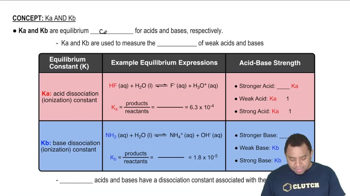Here are the essential concepts you must grasp in order to answer the question correctly.
Acid-Base Equilibrium
Acid-base equilibrium involves the balance between an acid and its conjugate base in a solution. In this case, HN3 is a weak acid that partially dissociates in water, while NaN3 provides the conjugate base (N3-). The pH of the solution reflects the concentration of hydrogen ions, which is influenced by the ratio of the concentrations of the acid and its conjugate base.
Recommended video:
Triprotic Acid Equilibrium
Henderson-Hasselbalch Equation
The Henderson-Hasselbalch equation is a mathematical formula used to relate the pH of a solution to the pKa of the acid and the ratio of the concentrations of the conjugate base to the acid. It is expressed as pH = pKa + log([A-]/[HA]). This equation is essential for calculating the molarity of NaN3 in this problem, as it allows us to determine the relationship between the pH, the concentration of HN3, and the concentration of NaN3.
Recommended video:
Henderson-Hasselbalch Equation
Dissociation Constant (Ka)
The dissociation constant (Ka) quantifies the strength of an acid in solution, indicating how well it donates protons (H+) to water. A lower Ka value, such as 1.9 x 10^-5 for HN3, signifies that the acid is weak and does not dissociate completely. Understanding Ka is crucial for calculating pKa and subsequently applying the Henderson-Hasselbalch equation to find the molarity of the conjugate base, NaN3.
Recommended video:
Characteristics of Ka and Kb
 Verified step by step guidance
Verified step by step guidance

